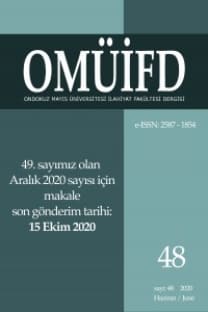Kur’an-ı Kerim’deki “Ekseru’n-Nâs” Lafzının Bağlamları ve MuhataplarI
Kur’an-ı Kerim nazil olduğu toplumda var olan sorunlara, yaşanan olaylara bir müdahale ve hitap olarak indirilmiştir. Kur’an’da anlatılan olayların gelişim aşamaları, ayrıntıları ve muhatapları nüzul vasatında yaşayanlarca bilindiği için, ayetlerin muhataplarının isimleri genel olarak açıkça zikredilmemiştir. Bunun yerine muhataplar "o, onlar, insanlar, insanların çoğu, mü’minler, kâfirler ve ehl-i kitap" gibi lafızlarla anlatılmıştır. Bu lafızlar, meallerin çoğunda anlamın hedef dile aktarılması şeklinde değil, sadece metnin tercüme edilmesi şeklinde çevrilmektedir.Bu çevirilerde ayetlerin muhatapları (mü'min, müşrik, Yahudi, Hıristiyan vb.) açıklanmadığı için, nüzul vasatını bilmeyen meal okuyucusu ayetlerin kime ne dediğini anlamakta sorun yaşayabilmektedir. Okuyucu benzer bir sorunu bu ayetlerin kendisine verdiği mesajı tespit etmede de yaşamaktadır. Toplam yirmi ayette geçen ve tamamen eleştirel bir içeriğe sahip olan ekseru’n-nâs lafzının anlaşılmasında da böyle bir sorun yaşandığını düşünüyoruz. Bu makalede ilgili lafzın muhatapları ve bu lafzın nasıl anlaşılması gerektiği tefsir literatürü temelinde açıklanmaktadır.
Contexts and Audiences of the Expression “Aksar‐un Nas” in the Holy Qur’an
The Holy Qur’an had been sent down as an active intervention and a speechto the existing problems and happenings in the society sent. Since the progresssteps, details and audiences of the subjects told in the Qur’an are knownto the people of that era, names of the audience of the verses were not usuallystated clearly. Alternatively, audiences are mentioned by expressions such as“he, them, humans, majority of humans, believers (mumin), disbelievers (kafir) and people of the book (ahl al‐Kitab)”. Those expressions are not interpretedin the way to reflect the meaning in the target language, but just translateddirectly in most of renditions.In those renditions, since the audience whether being believer (mumin),mushrik, Jewish or Christian is not expressed in paranthesis or in a differentway, the reader of the rendtion who do not know the conditions of the ermay have problems in understanding who is targeted by the message. Thereader has the similar problem in which degree he is questioned by theseverses and has difficulties in identifying the right message made to him by theverses. We think that such kind of a problem is seen in understanding theterm “Aksar‐un Nas” which is seen in twenty verses in total and having compeletelyjudgmental content. In this article, audience of the related expressionand how to be understood are described based on tafsir literature.
Keywords:
-,
- Yayın Aralığı: Yılda 2 Sayı
- Başlangıç: 1986
- Yayıncı: ONDOKUZ MAYIS ÜNİVERSİTESİ
Sayıdaki Diğer Makaleler
Hacc Sûresi 15. Âyetin Anlaşılmasında Etkili Olan Üç Problem Ve Çözüme Dair Yaklaşımlar
A Textbook Review '' The Power of Myth''
KUR’AN VE TARİHSELLİK: BEŞERİ EYLEMİN TOPLUMSAL SINIRI
İmam Hatip Liselerinde Dinsel Geleneklerin Öğretimi: Tespitler Ve Teklifler
Hanefi Mezhebinde, “Hukuksal Yorum Aracı” Olarak Evleviyet
TASAVVUF GELENEĞİNDE “ÖTEKİ” ALGISI
Kutbüddîn Şîrâzî’nin Dürretü’t-Tâc’ında Devir ve Cem‘İ-Kâmiller
BİREY VE TOPLUM AÇISINDAN DİN EĞİTİMİNE DUYULAN İHTİYAÇ
Kur’an-ı Kerim’deki “Ekseru’n-Nâs” Lafzının Bağlamları ve MuhataplarI
